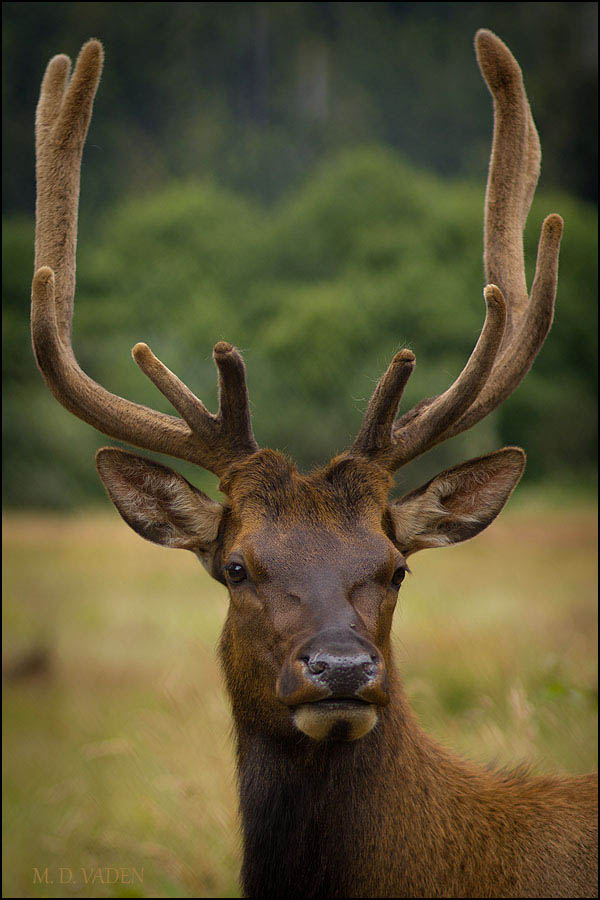
Roosevelt Elk at the Redwood Coast
A Few Places to Look
Copyright 2015 by Mario Vaden

advertisement
The creature in the photo is a male Roosevelt Elk. The species is the largest of the sub-species found in the United States. The herds are found up and down the Pacific Coast. These Elk can reach weights of 500 to 1200 pounds. Larger than a black bear. But it seems more caution should be exhibited around the Elk than with the bears. Bears often scram when people were around. But the Elk tend to hold their ground and can get irritated easily sometimes. They are worth finding. Usually its not hard to figure out what a safe distance is. They give body language clues like starting to ignore you if they feel you are far enough away. If you get too close, they may stand up, keep staring, or even walk toward you. If you want to know all the habits and stuff, I will let you research that part.
Mainly, I hope to offer some suggestions where you can see them, or ask.
1. Elk Prairie at Praiire Creek Redwoods State Park, Drury Scenic Pkwy., north of Orick. The grassy area is wide open. Look distant all the way back to the forest line. They may stand or you can look for antlers if they are resting. I've seen them as deep as a mile into the redwoods on a hiking trail, but the grassland is best to go looking for some.
2. Elk Meadow north of Orick, where Davison Rd. meets Hy. 101. Plenty of parking. Marked with signs.
Continue after image

3. Gold Bluffs Beach. North of Orick, take Davison Rd. 4 to 6 miles to Gold Bluffs Beach area. Roosevelt Elk could be anywhere along there. This is the route to Fern Canyon if you choose to visit it.
4. Between Orick and Bald Hills Rd. where Redwood Creek bends near Hy. 101. You may see elk down by the river. Or, turn down Bald HIlls Rd. for a moment and hang a right turn to the lane and parking for Redwood Creek trail. Elk may be along the stretch of trail between the trailhead and river.
5. Stone Lagoon / Hy. 101. You may see a Little Red School House and Elk Country RV park. Elk are frequently seen here along Hy. 101. It is between Orick and Trinidad.
6. Crescent City ... they may be harder to find here. If you needed a hint, you might ask the morning crew at the Curly Redwood Lodge Motel for a lead, or see if the Redwoods National Park visitor center may know where to look. It seems easier to spot herds down in Humboldt county, but Roosevelt Elk certainly live up in Del Norte county too. One of the largest I have seen was near the casino in the Howland HIll Rd. x Elk Valley Rd. area.
Elk Meadow Cabins, north Orick, or Redwood National Parks Kuchel visitor center, south Orick, are good places to inquire about where to find elk.
Traveling between Eureka and Crescent City, its not hard to find Elk. It may not be easy some days. But I spot a couple Elk or a herd about 75% of the time when just casually driving around.
Seasonal change
Males shed antlers February to March. Calves are born around May and June. Male antlers are fully grown by August. And rutting & breeding season is August to September. Males are very "on-edge" that time of year and should be give lots of space. Best to take photos from twice the distance as other months. They do not hibernate and can be found along the redwood coast all year.
History
As mentioned, I will let you research the lion's share. But I encourage you to read more. There is an interesting history. When explorer Jedediah Smith arrived around 1828 near Crescent City, he documented the effectiveness of native American Indian tribe pit traps for Elk, because his men's horses fell into some. As the "white" population grew, the Elk population diminished to as few as a single herd of 25 Elk in the Prairie Creek Redwoods State Park area. The numbers have recovered a lot.

advertisement